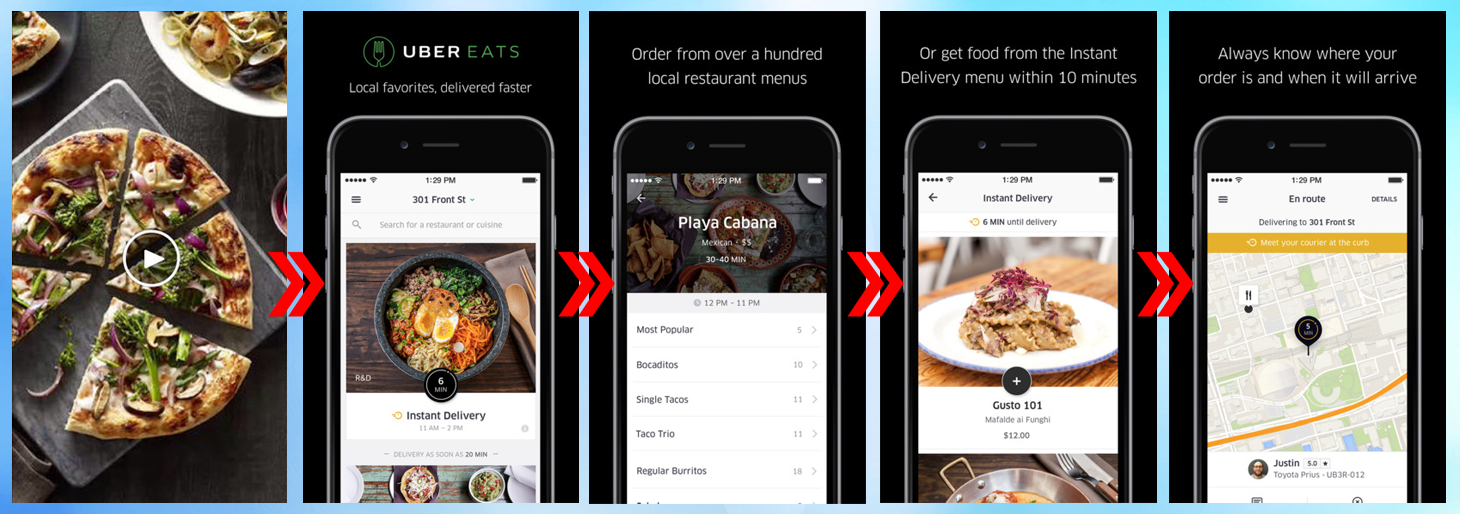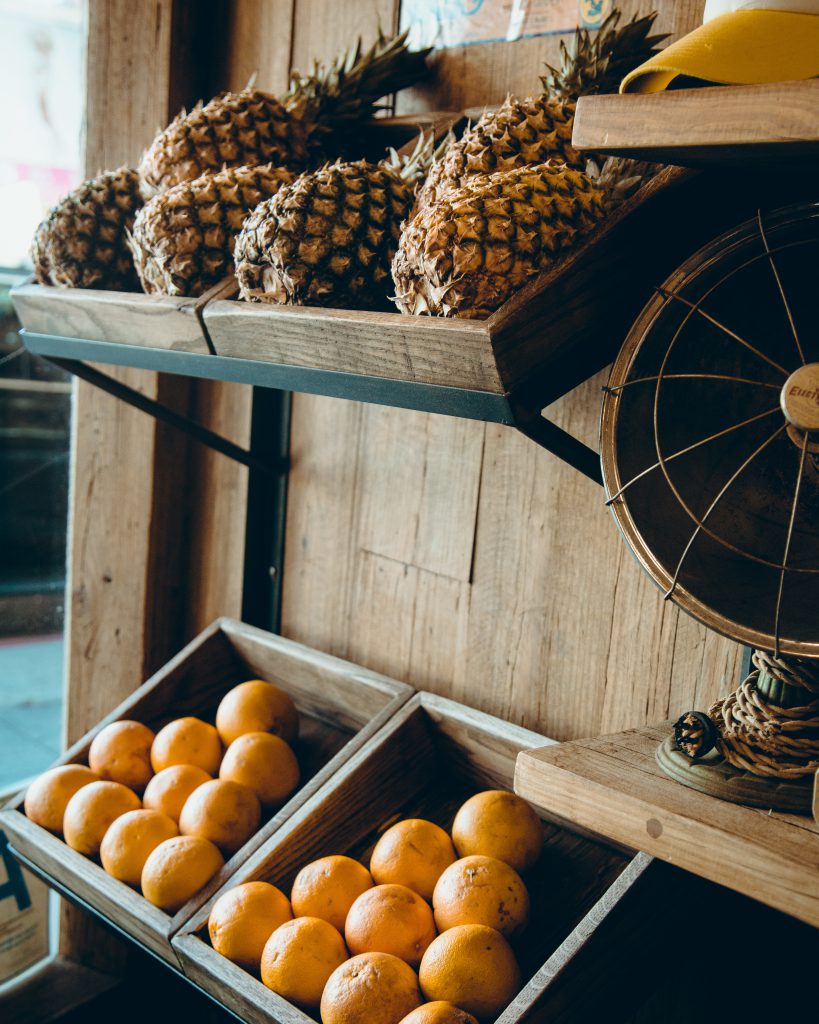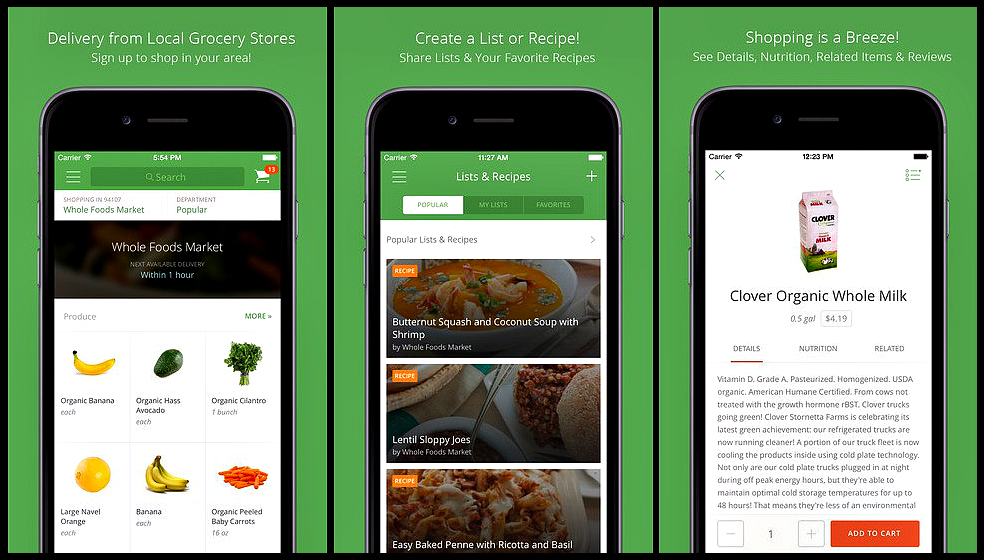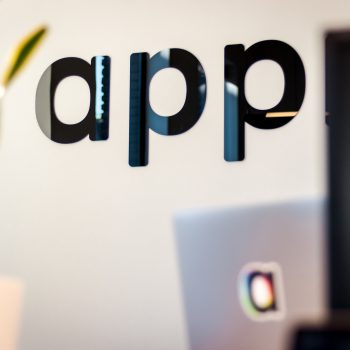
Insights of Apps Like Instacart
- Posted by Kateryna Bozhenko
- On March 16, 2018
- 0 Comments
- app, delivery, development, local, Octodev, restaurants, services
The tech boom of the past decade was made in part by on-demand companies. Indeed, e-shopping has dominated the retail sector, and has raised a revenue of approximately $120 million. So for aspiring app developers, there’s a strong foothold in the market. In some ways, it started with Spoon Rocket. The startup, based in Berkeley California delivered a selection of comfort foods straight to your door in under 15 minutes.
Instacart, and other local delivery apps that connect local restaurant and stores with customers, hit the market like a storm. We’ve talked a little about transportation apps in our other articles, but here, we’re going to examine in more detail what exactly these apps can do and how they are delivered.
A Changing Market
Instacart’s business model involves 3 main features; namely making connections with leading supermarkets, including workers (i.e. personal shoppers) to cover the actual delivery, and backs on the massive stockpiles that are an unfortunate by-product of the grocery industry. The company has a whole claims that it saves up to 30% on overall labour costs.
Market giants Amazon and Google have already jumped on the opportunity to expand their business, with Google’s Shopping Express, and of course, the innocuous Amazon Prime, which allows you unlimited deliveries of ‘prime eligible items (of which there are 20 million) for a $99 subscription for the year. Uber has launched its own take out service, UberEats, modeled on the idea of delivering fast food from restaurants in 10 minutes or under, with the menus varying by week.

But Instacart has emerged the Uber of groceries, operating as a grocery ordering and delivery app allowing users (grocery store buyers) to view a set list of products available, and further to get it delivered directly to their doorstep.
Users can buy a whole range of produce, from fresh fruits and vegetables, to meats and seafood, as well as other home essentials, all which is delivered at home with a few taps. The app does itself credit by saving on time and reducing the overall stress of finding, parking, queueing, and visiting multiple stores on end.
Instacart’s Insight
Apps like Instacart offer personalized and seamless shopping experiences, and delivery apps are modeled on either being able to offer a pre-set range of options, as UberEssentials does, or can host delivering a range of goods and services from anywhere, depending on demand. Of course, being able to order on demand opens the door to a range of possibilities, and certain iOS and Android apps enable their users to order just about anything from any restaurant that you specify.
Instacart at its core is a service that delivers groceries to your doorstep, by sending a personal shopper your way, in under an hour. You can pick from a range of grocery stores, depending on your area, including Whole Foods Market, Costco, Kroger, The Food Emporium, and Super Fresh.
The service works in 14 cities across the US, and sends your own personal shopper to the store of your choice, to have them delivery all your items to you in under an hour. It focuses more on the user’s shopping list, rather than specific stores.

Source: https://unsplash.com/photos/vlFeZzhlfzw
Postmates works a little like Instacart, in that it sends a local courier, also known as a ‘hipster on wheels’ to better deliver products from stores and restaurants. Indeed, Instacart really stands out as it modeled a whole new phase for the delivery market.
When we just look at Whole Foods, partnering with Instacart has helped increase online delivery sales to well over $1 million each week. So jumping onto the on-demand economy has its benefits, and can pay off greatly.
The app has five main features:
- User Sign In
- Categorization of Products
- Easy order placement
- Different payment methods
- Order Scheduling
Which might seem like a simple model, but that’s the brilliance of it. Instacart enables buyers to order fresh produce, at the time they want it delivered. Users can even use coupons, if they’re on hand and ‘favorite’ items to save for future reference. Furthermore, lists can be edited whilst their shopper is in the store in real time, and share these lists with friends and family.
They cut down the supply chain and reduce the need for owning a warehouse, and make the personal shoppers confirm the produce that is bought. They further monetize the app by using membership charges, and offer an annual membership ‘Instacart Express’ from $99 up to $159. This operates a little like Amazon Prime, but for groceries, and with this plan, users get free delivery of their groceries for up to 1 year.
Instacart also hikes 15% on actual prices, and this revenue then goes directly to Instacart to pay for their overhead costs and also pay the shoppers. They also make money from delivery charges, charging customers from $3.99 to $5.99, which can go up to $11.99 depending on location. There are issues in this industry, as in any, namely getting the right produce and ensuring that the personal shoppers are legitimate people, but as the industry matures there is certainly room to smooth these barriers.
What we can take learn from Instacart is how to use problem solving to our app’s advantage. All restaurants have the same problem: uneven client turnover. A mobile app helps shops and restaurants solve this problem of client turnover through connecting demand with supply. They fill a basic need in the economy: the need for groceries, and from their personal shoppers, benefit from an extensive network range.
Thus, Instacart has done to grocery services what Uber has done for taxi for hire, competing effective on the commodity everyone is seeking to capitalize of: convenience.

Developing an app like Instacart requires you to deal with product delivery, and thus you’d get the data from what the store had in stock directly from the store’ inventory. To solve the problem of not owning their own warehouse to sell goods in, they assemble their product bases from stores manually, purchasing all the products and taking photos of the purchases to upload online. It’s a novel approach, and one that various startups have integrated in some way.
Shotfarm, for example, acts as a free product image exchange which connect users directly with produce through their very own content network. Again, they don’t actually own the produce, it’s the manufacturers, distributors, and retailers who share their latest product attributes, images, nutritional value, etc. On the other hand, Kwikee provides access to up-to-date product images, further hosting API delivery alternatives for those interested in e-commerce or mobile development.
ItemMaster hosts a platform source of entirely free product images and, Gladson maintains a database of the product information of packaged goods in the U.S. moreover, there’s now farm-to-table services such as Door-to-Door Organics and meal delivery dedicated startups like Delivery Hero. So really, there’s a whole new market niche here that’s standing to take over traditional methods of grocery shopping.
Apps like Instacart, and the range of apps modeled after it specialize in not replacing regular grocery trips, but an alternative option for those working professionals or busy families that simply don’t have the time to go out shopping. It fills a hole in the market we didn’t even know we had! Indeed, Hari of Bigbasket, the front runner for the mobile grocery shopping industry in India, calls this market a “complex, execution-oriented business; understanding the execution and supply chain makes the real difference”.
The logistics of supply chain for grocery delivery now make it a viable business strategy, and makes for good investment. Indeed, it’s insightful how Instacart was able to fill that extra margin to cover various costs of infrastructure and logistics—now it connects consumers directly with produce that many very well go out of stock.
Certainly, Instacart has changed how we look at grocery stores for good.

Apps modeled after Instacart generally cost anywhere around $5,500 to $14,500 depending on platform you want it developed on. Detailed estimations will give you a better idea about the overall cost of design and development, as these factors depend on the level of inclusivity and the number of features you’ll want to be incorporated in your application. But no dream is too big.
Our professional developers will help you create a mobile grocery delivery app which offers only a seamless and personalized grocery shopping experience. Before we initiate app development, we will discuss all the specifications of your mobile app with you in great detail, to build you a highly functional app and include you in the process from start to finish.
It may seem like a challenge but developing an app for a smaller, underserved market has the potential for you to scale businesses and receive amazing results. And we want to help. Inquire more with us so we can help you build your grocery delivery application! So get in touch with us today, and we can lay the foundation of your business and development needs.











0 Comments